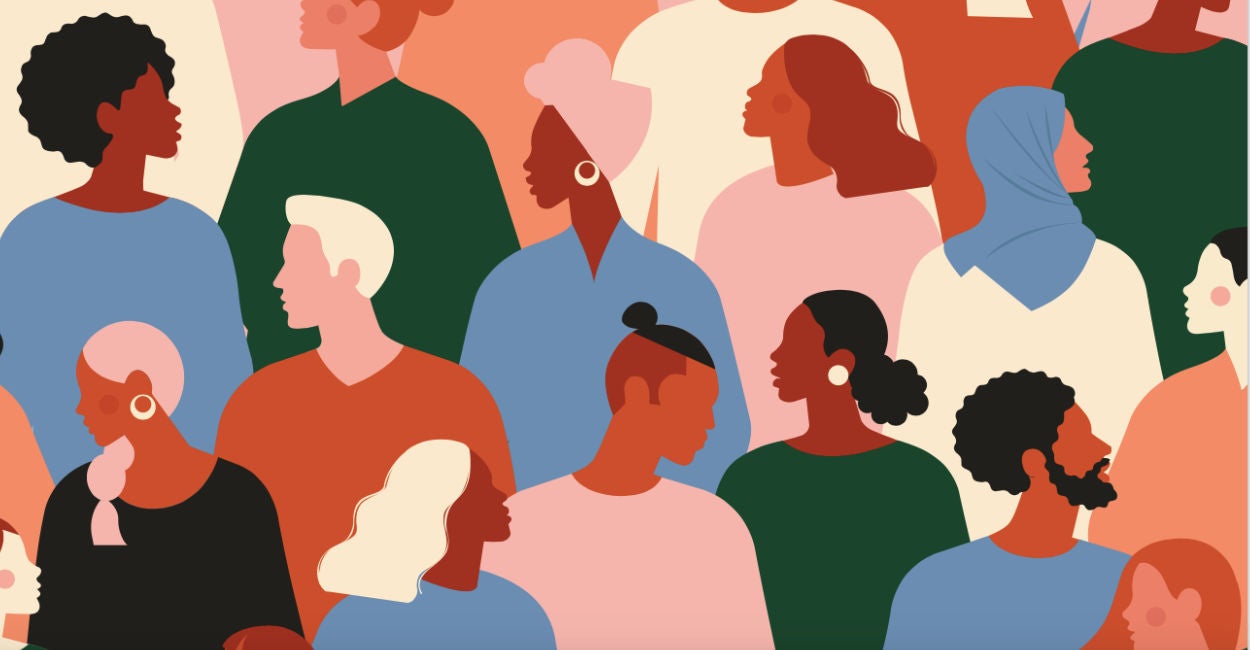Some governing areas fall neatly under easily recognized policy umbrellas. Relations with other countries come under the auspices of “foreign policy,” and when those relations break down and things end in a shooting war, then the “defense policy” folks come to the forefront.
Not so with one of the most important areas of life today: identity politics.
In this view, America is not a country where the individual is the main agent—one who, because of his very existence, possesses individual rights derived from his creator and/or his human nature.
The Daily Signal depends on the support of readers like you. Donate now
Instead, it’s one where membership in official categories (based on sex, race, etc.) is the identity that matters when it comes to rights, responsibilities, and everything else.
So, just as we should weigh the proposals of an upcoming administration regarding matters of fiscal or foreign policy, we also should scrutinize what policymakers and administrators would do either to repudiate or exacerbate identity politics. It is now a sphere that deeply affects Americans, no less than defense or health policy decisions.
Its aim, after all, is to revolutionize American society, including its economic system, into something different from what the American Founders laid out.
The Philadelphia Constitution vs. the Combahee River Constitution
The identity policy mindset has become so pervasive—not only in the academy and media, but in government policy—that more and more thinkers and politicians see the United States as now having two rival constitutions: the official one framed in 1787, and an unofficial one of much more recent vintage—the identity politics constitution.
A constitution is the fundamental law of a country, and as such it is always an important document. But in a place such as the U.S., where we lack common ancestors or a single, unifying religion or race, the Constitution takes on almost talismanic meaning. It is much more important than, say, the German Basic Law is to Germans.
Until this standoff between our rival constitutions in the U.S. is resolved, the country will engage not in normal politics but in the more volatile “regime politics,” which decides what regime we are to live under.
In one of the year’s best books, “The Age of Entitlement,” Christopher Caldwell explains that the two constitutions are incompatible.
“Much of what we have called ‘polarization’ or ‘incivility’ in recent years is something more grave. It is the disagreement over which of these two constitutions will prevail,” Caldwell wrote.
He’s not alone in this perspective. In his own forthcoming book “Crisis of Two Constitutions,” the Claremont Institute’s Charles Kesler explains how having rival legal blueprints affects our politics.
“Normal politics takes place within an accepted political and constitutional order … By contrast, regime politics is about who rules and for the sake of what ends in principles.” Regime politics are dangerous because they represent a clash “between two contrary visions of what constitutes the country.”
That rarely ends well.
Even Barack Obama agrees. In an excerpt of his new book that appeared in The Atlantic on Nov. 12, the 44th president writes, “Perhaps most troubling of all, our democracy seems to be teetering on the brink of crisis—a crisis rooted in a fundamental contest between two opposing visions of what America is and what it should be; a crisis that has left the body politic divided, angry, and mistrustful, and has allowed for an ongoing breach of institutional norms.”
No call for unity by the next administration, even if deeply felt, can force society to paper over this chasm. One side must win by convincing enough people on the other side that its blueprint is better and theirs is flawed—but then proceeding by not using its majority in an overbearing way.
Identity politics is at the very core of this divide. One constitution, the Philadelphia one (as amended since 1789), holds that all men are created equal, that they are endowed by their “nature and nature’s God” with unalienable rights that precede government, and that the purpose of the state is to protect those rights and to treat all citizens equally.
The rival constitution holds that we are a nation divided into categories, often contrived by government itself (such as the Hispanics and Asian Americans pan-ethnicities created in 1977 by the Office of Management and Budget, or the 31 genders approved by the New York City Commission on Human Rights).
In this regime, positive law creates rights and entitlements that are unequally distributed to members of these categories as a virtue of belonging to these categories—not because all of us possess faculties like reason and free will.
“Reparations” to descendants of former slaves (however remote the ancestry) to be paid by everyone else (no matter how distant they are from the evil of slavery, or even if none of their ancestors participated at all) would be one pure form of these benefits.
There are others in usage today, such as the racial preferences of affirmative action in education, preferential minority contracting and employment, the use of the “disparate impact” doctrine, etc.
The men in Philadelphia saw factionalism as a “dangerous vice,” one that could unite voters around interests or passions that are “adverse to the rights of other citizens, or to the permanent and aggregate interests of the community,” in the words of Publius (James Madison) in Federalist 10. By contrast, the rival constitution depends on factionalism for its very existence.
For the Constitution of ’87, a “well-constructed union” would seek ways to “break and control the violence of factions.” Not so for the rival constitution. Its purpose it is to erect those factions and make them permanent, even when members of a given faction no longer want to belong or were never content to be counted as members in the first place.
“Not naming the groups that face barriers only serves those who already have access,” writes the “anti-racism” consultant Robin DiAngelo, one of the preeminent promoters of the rival constitution, in her bestseller “White Fragility.” “Contrary to the ideology of individualism, we represent our groups and those who have come before us.”
For the Philadelphians, inequality was inevitable because there is a “diversity in the faculties of men.” Among other things, this naturally results in unequal wealth, something that is not considered inherently unjust. Factions are a function of the personal interests that arise from this inequality.
For the radical egalitarians of the rival constitution, inequalities arise from the fact that America is institutionally racist, sexist, homophobic, etc. These inequalities are inherently unjust and must be resolved by taking from the members of one faction and giving to the members of other factions.
It is here, at the confluence between inequality and faction (or category) that the chasm starts to open at its widest between the two regimes. The writers of one constitutional arrangement understood that inequality of wealth is a result of human nature—it is “sown in the nature of men”—but worried that it would lead to the factionalism. The system of government they devised was in fact an attempt at “curing the mischiefs of faction.”
The opposing side believes that these very institutions established by Madison and the other Founders in Philadelphia created today’s inequalities, which are the result of racism and any number of prejudices. Therefore, “the standards and institutions created by and fortifying white power ought to be resisted,” according to Derrick Bell, the acknowledged founder of critical race theory, the academic body of work that underpins identity politics.
The supporters of this rival constitution believe they can re-engineer society from the top down to obtain egalitarian outcomes. They therefore purposely erect factions—durable ones based on immutable characteristics, not class ones that can shift over time—as one of these remedies.
The aim of the Philadelphia Constitution of 1787 is to build an enduring republic based on natural rights. The other believes that “the concept of rights is indeterminate, vague, and disutile,” in Bell’s words.
“Moral and legal rights are apt to do the rights holder much less good than we like to think,” adds Richard Delgado, another founder of critical race theory, writing with his wife, Jean Stefancic. Our system of rights “applauds affording everyone equality of opportunity but resists programs that assure equality of results.”
The aim of the rival constitution, then, is to make us see the America produced by Philadelphia as a fundamentally, systemically, structurally, and institutionally racist one, so that we can transform the system into something entirely different. Capitalism, which is an expression of the commercial republic of ’87, must be eliminated because it rewards some and punishes others, and does so according to rigged rules. What the rival dispensation seeks is equalized economic outcomes according to membership categories.
Leftist thinkers and opinion makers encourage us to interpret opposition to this new, rival constitution as “fear of cultural change” by white Americans. They are said to be trying to mount a doomed rearguard stand against inevitable progress. This transformation of the country, the progressive argument goes, is unavoidable because of demographic change, and demography is destiny.
“It was cultural anxiety—feeling like a stranger in America, supporting the deportation of immigrants, and hesitating about educational investment—that best predicted support for Trump,” one writer at The Atlantic intoned, rather condescendingly, after the 2016 election.
But America’s demography has always been churning. America has remained America by acculturating newcomers to its core beliefs, not the other way around. There is nothing inevitable about adopting these new standards. It is a policy choice, and therefore a political choice.
Since the term “identity politics” was first used in the Combahee River Collective Statement of 1977, I propose using that as the year of this new informal constitution’s birth.
The Combahee River Collective Statement is not a constitution; it does not spell out rights for citizens. Its only use of the word “rights” is when it’s coupled with “abortion.” In fact, the statement opposes individual rights in that it calls for reorganizing the economy around the “collective benefit” of the workers.
The writers, a group of African American feminists, declare themselves to be socialists because “the liberation of all oppressed peoples necessitates the destruction of the political-economic systems of capitalism.”
The Combahee River Collective Statement does identify the key element in identity politics—oppression or victimhood—in its single mention of the term: “This focusing upon our own oppression is embodied in the concept of identity politics. We believe that the most profound and potentially most radical politics come directly out of our own identity.”
The statement’s very opening line reads, “The most general statement of our politics at the present time would be that we are actively committed to struggling against racial, sexual, heterosexual, and class oppression.”
In the new paradigm under which many Americans now operate, as outlined by the informal constitution, victimhood is what commands attention, respect, and entitlements, seen as compensatory justice. Under the old, de jure Philadelphia Constitution, it is our human faculties that endow us with rights.
As David Azerrad puts it, the Combahee River Collective Statement’s “understanding of identity politics still shapes the broad contours of identitarian thinking to this day.”
Time to Choose
Caldwell is right about the incompatibility of the two regimes. The Combahee Constitution’s policy prescriptions effectively violate most of the 10 amendments in the Bill of Rights (if not all of them), as well as others added later, such as the Reconstruction Amendments.
One of the reasons the Combahee River constitution has gone unchallenged for so long is that it comes across as sympathetic to those in need. Americans have fought for women’s rights, civil rights, and human rights for so long that anything wrapped in the rhetoric of helping the downtrodden will have a clear advantage.
But this is not what identity politics, with its divisiveness and postmodernist rejection of absolute truth, does. Nobody’s life will improve if we jettison capitalism.
It is important to come to terms with this constitutional rivalry and resolve it once and for all. The states ratified the Philadelphia Constitution of 1787, and it has produced 232 years of liberty and prosperity. Nobody, conversely, has ever voted for the 1977 Combahee rival.
The situation is worsened by the fact that while many philanthropists support the Philadelphia Constitution, the Combahee River constitution has deep-pocketed backers who accept the claim that America is hopelessly grounded in injustice. They are prepared to put the wealth they have acquired thanks to American capitalism into support for organizations such as the Marxist-influenced Black Lives Matter organization, to the tune of millions.
Some of the wealthiest families in America—such as the Soros, Buffett, and Rockefeller families—and much of corporate America are involved in this effort.
The Combahee River Policies
How do philanthropists who care about defending the Philadelphia Constitution (and preventing the de facto Combahee River one from becoming de jure) keep track of how the next administration will do on these fronts?
The actual policies that give life to the identity politics constitution fall under different areas—education, the census, housing, etc. It might be instructive to think of it as a holding company, one in which policies usually covered under different rubrics converge to produce the identity politics constitution.
So what are those policy areas? The main ones are:
- The pervasive use of the disparate impact doctrine at all levels of government.
- The racial preferences of affirmative action.
- The creation of categories by the decennial U.S. census.
- The critical race theory trainings to which employees and students are now routinely submitted.
- The transformation of history from an examination of facts that gives shape and meaning to our shared lives into an effort to confirm an already-postulated thesis, “a thesis that puts racial grievance at the center of America’s story,” as Peter Wood writes in his recently published book “1620: A Critical Response to the 1619 Project.”
- The degree to which individuals who promote these and other causes (such as the consultant Robin DiAngelo; the Boston University professor Ibram X. Kendi; the founders of the Black Lives Matter organizations Patrisse Cullors, Alicia Garza, and Opal Tometi; or politicians such as Stacey Abrams) are allowed to have influence over the levers of power.
- Bias-response teams and other speech codes at universities.
- Sex education in K-12 schools that denies biology.
- Fat studies that deny the harm stemming from obesity, pushing doctors to avoid treating it.
- Embracing violent protests because existing power structures must be deconstructed.
- Making workplaces unsafe for those who do not accept the new orthodoxy of “the woke.”
What to watch for among the top three of these policy areas:
Affirmative Action: The institutionalization of racial preferences is the mother’s milk of identity politics; it suborns people into adhering to victimhood categories in order to become eligible for benefits. This is especially the case among high school juniors anxiously applying to universities.
The Trump administration used several levers of government to side with a growing movement among Chinese American parents to end the racial preferences of affirmative action.
The White House, for example, filed an amicus brief on behalf of Asian students suing Harvard; the Justice Department sued Yale, saying it violated the civil rights of Asian and white students by discriminating against them; and the Department of Education’s Office for Civil Rights took the side of Chinese American parents complaining that public schools in Montgomery County, Maryland, were violating their rights.
Would a Biden administration follow this pattern? No one thinks that. Ultimately, however, that may not matter, as it will be up to the Supreme Court to decide this issue. The Harvard case seems to be the one that will get there first.
In this sense, President Donald Trump’s judicial appointments should be helpful in this area; no true originalist could ever pretend that the Constitution, as written, supports racial preferences. The justices would do well to heed California voters’ overwhelming rejection of the attempt to bring back racial preferences in their state in the just-concluded 2020 election.
Category Creation: If racial preferences offer the enticements that nourish identity politics, categories are its lifeblood. Without them, the system collapses. This is why activists and ideologues fought so hard to force bureaucrats—going so far as to intimidate them at times—to officialize the categories.
This is also why, today, ethnic affinity groups such as the National Association of Latino Elected and Appointed Officials and Asian Americans Advancing Justice are in control of the Census Bureau’s National Advisory Committee on Race and Ethnicity.
In 2016, the Obama administration tried to formalize the Hispanic category (currently an “ethnicity” question that is separate from the race question) by collapsing both of them into a single question of “categories.” The administration also sought to create yet another victim category: one for Middle East-North Africa, or MENA.
The first action would have perpetuated and deepened the “Hispanic” identity, which is what the left wants, and second simply would have added yet one more group. The Trump administration decided against such moves. (I am happy to say that I played a role in advocating against accepting these changes.)
The Biden campaign has already said it wants to bring MENA back. Any return to these changes would signal a deepening of the Combahee River Constitution. Rather than do that, we should get rid of the existing categories.
Critical Race Theory Trainings: Critical race theory, lastly, is the main tool through which identity politics is implemented. Bell did not hide his intentions when he wrote in a foundational 1995 essay on the subject, “As I see it, critical race theory recognizes that revolutionizing a culture begins with the radical assessment of it.” This is, indeed, critical race theory’s goal (and the goal of identity politics): to revolutionize America into something fundamentally different.
All the leading proponents of these trainings—DiAngelo, Kendi, Darnisa Amante-Jackson, Glenn E. Singleton, and others—are on the record as wanting to rid America of capitalism, insisting that its rewards system smiles only upon Western traits. (Among these they include, without embarrassment, habits such as punctuality, love of the written word, the use of reason, and hard work.)
These trainings, therefore, aim at eliminating capitalism. The Trump administration earned the support of many for insisting that federal workers could not be subjected to this form of workplace harassment. A Biden administration would surely rescind this ban.
These are just three of the main policy areas being used to promote and perpetuate the identity politics constitution. Americans who support this new dispensation must explain to the rest of us how eliminating the idea that all individuals must receive equal treatment from government and abolishing capitalism itself can help anyone in society, especially those who are disadvantaged today.
Those of us who believe that we must go back to implementing the fundamental law of the country as written need to understand what is taking place and become more vocal in the defense of the existing Constitution.
There doesn’t seem to be too much room for compromise. Only one side can prevail.
Originally published by The Philanthropy Roundtable






























